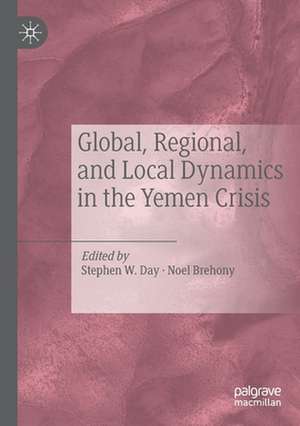Global, Regional, and Local Dynamics in the Yemen Crisis
Editat de Stephen W. Day, Noel Brehonyen Limba Engleză Paperback – 11 feb 2021
| Toate formatele și edițiile | Preț | Express |
|---|---|---|
| Paperback (1) | 946.17 lei 6-8 săpt. | |
| Springer International Publishing – 11 feb 2021 | 946.17 lei 6-8 săpt. | |
| Hardback (1) | 950.57 lei 6-8 săpt. | |
| Springer International Publishing – 11 feb 2020 | 950.57 lei 6-8 săpt. |
Preț: 946.17 lei
Preț vechi: 1153.87 lei
-18% Nou
Puncte Express: 1419
Preț estimativ în valută:
181.07€ • 196.62$ • 152.10£
181.07€ • 196.62$ • 152.10£
Carte tipărită la comandă
Livrare economică 23 aprilie-07 mai
Preluare comenzi: 021 569.72.76
Specificații
ISBN-13: 9783030355807
ISBN-10: 3030355802
Pagini: 321
Ilustrații: XXXI, 321 p. 2 illus.
Dimensiuni: 148 x 210 mm
Greutate: 0.47 kg
Ediția:1st ed. 2020
Editura: Springer International Publishing
Colecția Palgrave Macmillan
Locul publicării:Cham, Switzerland
ISBN-10: 3030355802
Pagini: 321
Ilustrații: XXXI, 321 p. 2 illus.
Dimensiuni: 148 x 210 mm
Greutate: 0.47 kg
Ediția:1st ed. 2020
Editura: Springer International Publishing
Colecția Palgrave Macmillan
Locul publicării:Cham, Switzerland
Cuprins
Chapter 1: Introduction
Stephen Day
Part I — Global Dynamics
Chapter 2: The Role of the United Nations in the Yemen Crisis
Helen Lackner
Chapter 3: The British Role in the Yemen Crisis
Noel Brehony
Chapter 4: America’s Role in the Yemen Crisis
Stephen Day
Chapter 5: The European Union’s Role in the Yemen Crisis
Laurent BonnefoyChapter 6: The Russian Role in the Yemen Crisis
Samuel Ramani
Chapter 7: The Chinese Perspective on the Yemen Crisis
I-wei Jennifer Chang
Part II — Regional Dynamics
Chapter 8: Saudi Arabia’s Role in the Yemen Crisis
Bruce Riedel
Chapter 9: The UAE Role in the Yemen Crisis
Noel Brehony
Chapter 10: Iran’s Role in the Yemen Crisis
Alex Vatanka
Chapter 11: Omani and Qatari Roles in the Yemen Crisis
Abdullah Baabood and Ahmed Baabood
Chapter 12: Turkey and Egypt in the Yemen Crisis
Özlem Tür
Chapter 13: The Horn of Africa and the Yemen Crisis
Alex de Waal
Part III — Local Dynamics
Chapter 14: The Role of “Legitimacy,” Hadi and the Islah Party
Nadwa al-Dawsari and Summer Nasser
Chapter 15: The Role of “Coup Forces,” Saleh and the Houthis
Luca Nevola and Baraa Shiban
Chapter 16: The Role of Hirak and Southern Transitional Council
Stephen DayChapter 17: The Role of Muslim Brothers, Salafis, and Jihadis
Laurent Bonnefoy and Manuel Almeida
Part IV — Conclusion
Chapter 18: Conclusion
Noel Brehony
Notă biografică
Stephen W. Day is Adjunct Professor of International Affairs at Rollins College, and former Visiting Assistant Professor of Middle East Politics at St. Lawrence University and Stetson University, USA.
Noel Brehony CMG is Honorary Vice President and former Chair of the British Yemeni Society. He is former President of the British Society for Middle East Studies and former Chair of the Council for British Research in the Levant.
Textul de pe ultima copertă
This international relations study investigates the underlying causes of the Yemen crisis by analyzing the interactions of global, regional, and local actors. At all phases, GCC member states played a key role, from political negotiations amidst street protests in 2011 to formation of an international military coalition in 2015. Using a multi-actor model, the book shows that various actors, whether state or non-state, foreign or domestic, combined to create a disastrous armed conflict and humanitarian crisis. Yemen’s tragedy is often blamed on Saudi Arabia and its rivalry with Iran, which is usually defined in sectarian “Sunni-Shia” terms, yet the book presents a more complex picture of what happened due to involvement by many other foreign actors, such as the UAE, UN, UK, US, EU, Russia, China, Turkey, Oman, Qatar, and African states of the Red Sea and Horn of Africa.
Stephen W. Day is Adjunct Professor of International Affairs at Rollins College, and former Visiting Assistant Professor of Middle East Politics at St. Lawrence University and Stetson University, USA.
Noel Brehony CMG is Honorary Vice President and former Chair of the British Yemeni Society. He is former President of the British Society for Middle East Studies and former Chair of the Council for British Research in the Levant.
Caracteristici
Offers the reader a rigorous, well-researched analysis of how and why the political crisis and war in Yemen occurred
Provides crucial historical background information extending back to 2010, one year before the Arab Spring
Brings together contributions from top scholars, examining Yemen's political crisis and war through the lens of the multiple-actor analytical model
Considers the internal roles of President Hadi, former president Saleh, Houthi rebels, the Islah party, Hirak movement, Southern Transitional Council, and various Salafi and Jihadi groups like al-Qaeda on the Arabian Peninsula (AQAP)
Provides crucial historical background information extending back to 2010, one year before the Arab Spring
Brings together contributions from top scholars, examining Yemen's political crisis and war through the lens of the multiple-actor analytical model
Considers the internal roles of President Hadi, former president Saleh, Houthi rebels, the Islah party, Hirak movement, Southern Transitional Council, and various Salafi and Jihadi groups like al-Qaeda on the Arabian Peninsula (AQAP)
